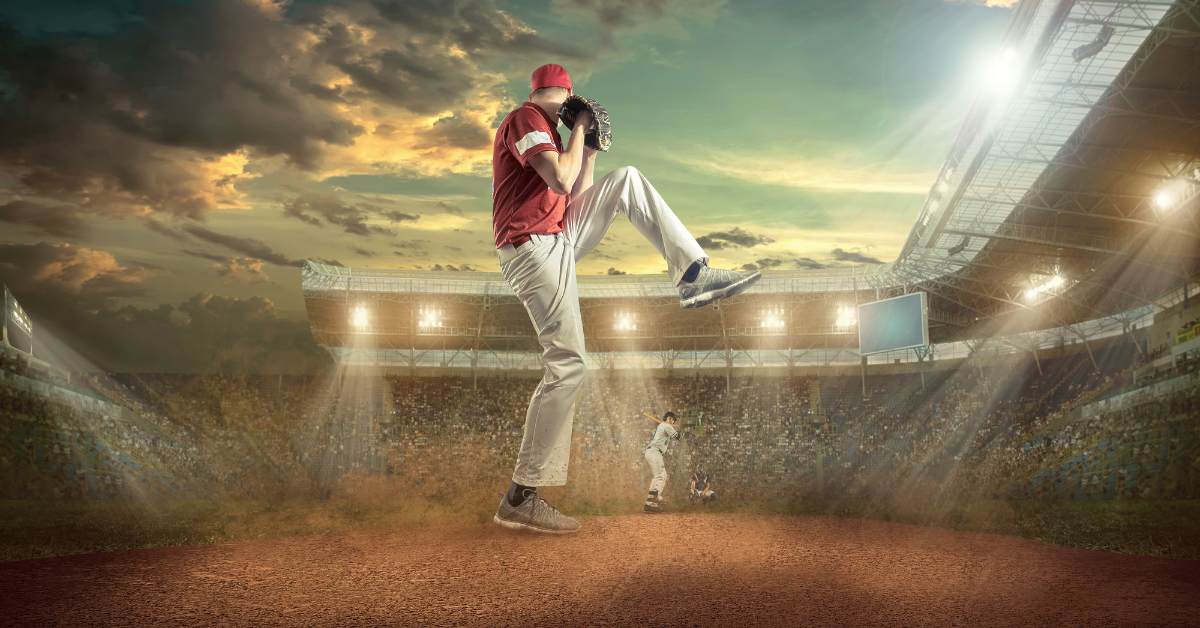
Baseball and Softball Arm Injuries: How do I return to throwing?
By Dr. John Mishock, PT, DPT, DC
The success of the baseball pitcher requires not only high-level ability but also durability and prevention of injury. The baseball throwing motion has been described as one of the most violent and stressful motions in all sports. The arm experiences velocities greater than 9000 deg/s and distraction forces. The distraction force, or the arm bone being pulled away from the shoulder joint, is up to 382 lbs at ball release. It is the job of the rotator cuff, four muscles around the shoulder, to dissipate the force. (Fleisig et al. Am J Sports Med. 1995) If the rotator cuff is not strong and the player throws too much, injury to the shoulder can occur. The forces on the elbow during throwing are no less. At the late cocking phase of the throw (when the arm lays back and is loaded), the elbow and Tommy John Ligament (ulnar collateral ligament) experience forces (varus force) that are equivalent to holding a 75 lb. dumbbell in the hand. Coupling the violence of given throws is the overuse of playing on multiple baseball teams simultaneously, year-round play, throwing with arm fatigue, and insufficient rest and recovery. All of this leads to a recipe for the epidemic of arm injuries seen in youth, collegiate, and professional athletes.
Science has also shown that in elite baseball pitchers, 85% of throwing velocity comes from leg drive (push-off and stride length), hip and torso rotation (shoulder-hip separation), and shoulder cocking (scapular loading and shoulder layback). (Roach et al., 2014) Therefore, the arm only accounts for 15% of the throwing velocity in elite baseball pitchers; however, nearly 50% of all MLB-related injuries are of the elbow or shoulder, accounting for approximately 460,432 days on the disabled list at an economic cost of 2.5 billion dollars, with the numbers continuing to rise. (Oberalander Sports Med Arthrose, 2000; Polster et al. Am J Sports Med 2013)
While on the disabled list, the athletes are going through a physical therapy rehabilitation program to expedite tissue healing and recover from the impairments of the injury, such as; a lost range of motion, reduced strength, impaired motor control, and inadequate flexibility. A critical component of any rehabilitation program following arm injury is a graduated exposure of the injured tissues (muscle, ligament, or tendon) to throwing and competitive play. An interval throwing program is implemented during the physical therapy process of an arm injury to return the athlete to baseball competition.
The interval throwing program must be implemented with appropriate timing, intensity, and volume to optimize mechanical stress and load to enhance healing. Furthermore, the throwing program must be progressed over time to avoid re-injury.
More recently, at the professional and collegiate levels, technological advancement has allowed for improved analysis of throwing mechanics through motion capture systems. A detailed description of pitching mechanics can be found in my book “The Rubber Arm: Using Science to Increase Pitch Control, Improve Velocity, and Prevent Elbow and Shoulder Injury,” located on Amazon.
Regardless, the athlete must meet all the rehabilitation metrics in range of motion, strength, flexibility, and motor control before returning to throwing. In the past, interval-throwing programs were created as one-size-fits-all, all with minimal customization based on an arbitrary timeline during recovery, with the volume and intensity of throws progressing in the same manner independent of the individual’s recovery. There has been a shift to a criterion-based approach to initiating and advancing the interval throwing programs based on the biology of tissue healing and performance measures (range of motion, muscle strength, flexibility, throwing mechanism) to determine overall athlete readiness to throw. The evolving knowledge of how the baseball player responds to throwing is critical in the decision-making to progress the athlete in the throwing program.
If you are an injured baseball or softball player looking to return to throwing following injury, we can help. Also, attached to my blog, mishockpt.com/blog, you can find an example throwing program. Again, keep in mind that this is a guide that must be adapted to meet the specific needs of each individual related to readiness to pitch, volume, intensity, and frequency of throwing.
We can help!
If pain or limited function limits you from doing the activities you enjoy, call Mishock Physical Therapy for a Free Phone Consultation (610)327-2600. Email your questions to mishockpt@comcast.net. Visit our website to learn more about our treatment philosophy, our physical therapy staff, and our 7 convenient locations in Gilbertsville, Skippack, Phoenixville, Boyertown, Limerick, Pottstown, and Steiner Medical at www.mishockpt.com.
Schedule your visit by calling 610-327-2600 or visiting this link: https://mishockpt.com/request-appointment/
Gilbertsville – Skippack – Phoenixville – Boyertown – Pottstown – Limerick
Visit our website to read informative articles, meet our physical therapy staff, and learn about our treatment philosophy. Email your questions to mishockpt@comcast.net
Dr. Mishock is one of only a few clinicians with doctorate-level degrees in both physical therapy and chiropractic in the state of Pennsylvania. He has authored two books; “Fundamental Training Principles: Essential Knowledge for Building the Elite Athlete”, and “The Rubber Arm; Using Science to Increase Pitch Control, Improve Velocity, and Prevent Elbow and Shoulder Injury” both can be bought on Amazon and train2playsports.com.

